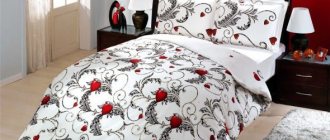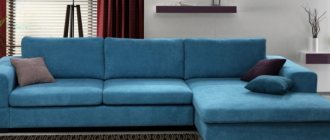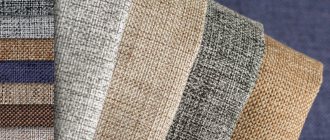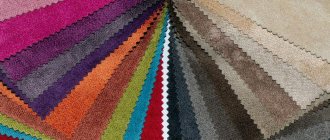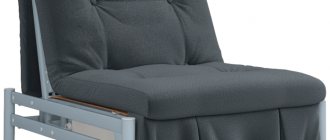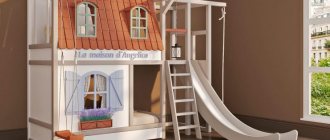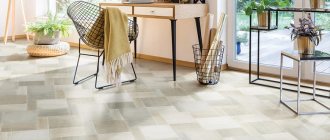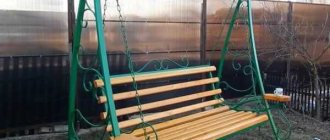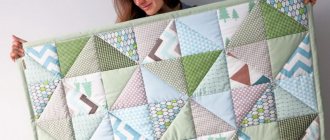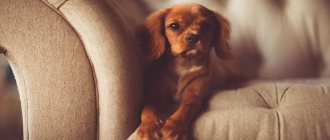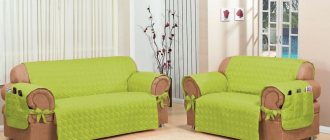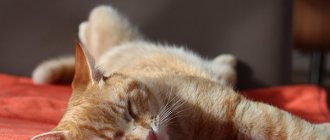An untidy appearance of a sofa or bed is a problem for many housewives who love cleanliness. If you put a blanket on the furniture, the house will not only look beautiful, but the furniture will also last longer. The housewife can only choose a ready-made bedspread or fabric for a bedspread on the sofa if she decides to sew something for her beloved home herself. We have prepared tips for you on how to choose the right fabric for a bedspread according to its purpose, composition and design.
Functions
The purpose of the fabric is different: sometimes it is subject to regular wear and tear and, accordingly, is often washed and cleaned, and some simply decoratively cover all or part of the sofa. Therefore, the fabric must meet the following requirements:
- Density that allows the surface to be well protected from mechanical deformation and dirt;
- Softness, pleasant tactile sensations, well suited for children;
- Hypoallergenic, it is desirable that the material consists of natural fibers, but without the addition of artificial fibers it will not last long;
- Thermal conductivity, it is much more pleasant to touch a warm material in the cold season and cool material in the summer;
- Hygroscopicity, it is desirable that the fabric absorbs moisture and evaporates it;
- UV resistance, with poor resistance, the material gradually loses its attractive appearance, the print fades and the structure of the fabric is destroyed.
Cape shapes
- Fur or wool. The most suitable option for cold evenings. The fabric of such capes is not always very dense and you need to be careful when washing.
They give the room softness and magical charm, completely insulating it with just one look.
- Natural silk. Will make your room expressive and light. The reflection of silk strands is suitable for the summer and spring mood in the house.
- Linen and cotton. Variants of such capes are often made in pastel colors. The room and the covered furniture will have an elegant and expensive look. Covers are mainly used: on a folding sofa, corner sofa, on an armchair and armrests
Covers are mainly used: on a folding sofa, corner sofa, on an armchair and armrests
Types and options of materials
Now there is no shortage of fabrics and the main thing when choosing is not to get confused and clearly know what you want. The choice is huge and you need to focus on creating harmony in the finished interior and take into account your preferences.
There are many options. When choosing fabric, you need to focus on the interior, the purpose of the bedspread and your taste.
Types of fabrics for bedspreads on a sofa:
- Cotton;
- Polyester;
- Tapestries;
- Microfiber;
- Velor or velvet;
- Velsoft;
- Flannelette;
- Natural or artificial fur;
- Satin;
- Silk;
- Viscose;
- Fleece;
- Blended fabric (composition of a mixture of only natural or natural and artificial fibers).
Some of the listed fabrics are very dense and durable, while others, such as satin or silk, are thin and have purely decorative value.
Optimal bedspread size
In order to understand what size bedspread we need, we need to take measurements from the bed itself (length, width). It is worth noting that the product that hangs down from the mattress looks best, so you should add about 60 centimeters to the width of the bed, and 30 centimeters to the length.
An example of a voluminous satin bedspread
Quilted fabric products
Quilted fabric for bedspreads is first-class for making a truly warm product. To obtain quilted fabric, you need to put and sew some kind of insulation, different in thickness, between two dense fabrics, for example holofiber or thin foam rubber. Usually these are cotton, blended or synthetic fabrics.
How to cover a corner sofa?
For the decoration of a corner structure, both one-piece canvases and several separate covers at once are equally suitable. If the sofa is located in the center of the room, its back should also be protected by a cover.
Fragmentary products, due to special fastening elements in the form of buttons, elastic bands, cords or metal fittings, hold tightly and do not slide off the non-standard sofa structure.
Fabric for blanket
The fabric for a blanket on a sofa made of viscose is the softest and most pleasant to the touch, but its care must be very careful. Synthetic (polyester) and semi-synthetic or semi-natural fabrics (polysatin, denim) are less susceptible to wear.
Cotton
Depending on the method of weaving the threads, the following types of cotton fabric can be distinguished:
- Linen (poplin, calico, chintz, taffeta);
- Twill (fleece, flannel, denim);
- Satin (satin).
Plain weave
Advantages
This fabric is quite inexpensive, hypoallergenic, breathable, absorbs and evaporates moisture, does not electrify, you can easily sew a bedspread from it and it is easy to care for.
Flaws
The dimensions after washing may differ from the original ones, as the fabric shrinks, so before sewing the material must be wetted, dried and ironed. After the procedures, measure the dimensions again. The material wrinkles easily, like all natural fabrics, this must be taken into account based on the purpose of the bedspread.
Satin weaving and its varieties
The satin weave of the fabric differs from the rest in its elongated overlap on the front surface. This weave produces fabrics that are smooth to the touch. With a high twist of threads, the fabric gets shine.
Varieties:
- Satin jacquard, the fabric does not have a reverse side, sometimes one side has a richer side, and the other is simpler, complex weaving of threads and applying a pattern to the material gives a rich effect and is not cheap;
- Mako satin is the most expensive fabric, has a very dense weave;
- Crepe-satin, sometimes containing artificial silk threads;
- Silk is satin; when weaving the fabric, the front thread consists of silk, the back thread consists of cotton.
- Milatex, a complex weave of threads allows you to get a beautiful shine, looks expensive, so items are made “in plain sight”: tablecloths, curtains, drapes;
- 3D satin, the design is applied using photo printing, highlighting the foreground with clarity and slightly blurring the background, resulting in a 3D effect;
- Mensi, the material is double-sided: on one side it is satin and on the other, fleece;
- Polysatin, due to the displacement of satin and polyester, it is possible to obtain a velvety surface.
Advantages
This material always looks expensive and elegant, allows air to pass through well, absorbs and evaporates moisture, and is hypoallergenic.
Flaws
You have to pay for quality, this is exactly the case with satin materials; they require careful care and handling.
Wool jacquard
The great possibilities of weaving production make it possible to use a higher-quality thread on the front side when receiving fabric, due to the interweaving of threads, adding shine and a rich appearance to the material; besides, weaving allows you to obtain large patterns on fabrics.
Advantages
Expensive production when weaving threads, still allows you to obtain fabrics with high wear resistance, and if the fabric is handled with care, then a bedspread made from such fabric will please you with its appearance and will serve you for many years. Such materials have a wide selection of colors and patterns, are warm, environmentally friendly, allow air to pass through, and absorb and evaporate moisture.
It’s interesting to know, read about checkered blankets in the article: – Woolen Scottish checkered blankets - description and varieties.
Flaws
Complex weaving sometimes causes a “prickly, scratching” effect, which can lead to allergies, which is also facilitated by dye compositions. Fabrics for a bedspread for a bed or sofa of this type are by no means budget-friendly.
Silk
Since ancient times, bedspreads made from this fabric have received recognition and love from people; they decorated their homes and furniture with them.
Advantages
No fabric can compare to the tactile sensations of silk. It has good qualities: it does not electrify and does not create dust, it is bactericidal, it does not harbor mites and infectious insects, it is breathable, hygroscopic and very durable.
Flaws
The material is expensive, slips and wrinkles a lot, you need to iron it with a warm iron.
Tapestry
This is a special weave of fabric that can be related to art. Since ancient times, craftswomen worked with wool and silk threads, adding gold and silver, and received carpets that they hung on the wall, decorating their homes.
With the development of weaving technologies, the production of tapestry fabrics received new dynamics in development. In the modern world, these are actually dense jacquard fabrics that have a mixed structure and composition, which has improved the quality and reduced their cost.
Advantages
The material has good strength and wear resistance, a large selection of compositions and colors, a wide variety of prints, a rich and beautiful appearance, easily fits into the interior of the house, warm, hygroscopic.
Flaws
Difficult to care for, many are undesirable to wash, but it is better to use dry cleaning services, hard fabric.
Atlas
This material has a rich history and is a good substitute for silk fabrics, as it has the same luxurious shine; the word “satin” is called “smooth” in Arabic. Since ancient times, fabric was created in China from silk and, due to the complex interweaving of threads, an extraordinary shine was achieved.
In modern production, the composition of fabrics has changed; Blended threads are very often used to reduce the cost of the material. Threads are obtained by mixing natural and artificial raw materials.
Advantages
It has a pleasant tactile sensation, similar to cool water. It allows air to pass through well, absorbs and evaporates moisture, is durable, does not become electrified and does not spread dust. It drapes very beautifully and is easy to sew; it is better to use it as a decorative covering for a sofa or bed.
Flaws
When cutting, you need to quickly trim the edges of the fabric, as it frays quickly. Requires careful care and use.
Viscose
This material is artificially produced from natural raw materials - wood cellulose.
Advantages
The material is very soft, pleasant to the touch, has all the advantages of a natural composition: it absorbs and evaporates moisture well, retains heat, allows air to pass through, is very comfortable, does not collect dust and does not electrify, is also durable, easy to sew, has many colors and a wide selection prints and patterns.
Flaws
Needs careful care and handling, fades in the sun, wrinkles.
Acrylic
This material of synthetic origin appeared in the modern world in the mid-20th century in America; it was first obtained from gas. Although it consists of synthetics, its properties are very similar to natural ones. Currently, the material mainly has a mixed composition, i.e. Acrylonitrile is mixed with natural raw materials, which can reduce the negative effects of synthetics and are more used for the production of knitted items.
Advantages
Soft, pleasant to the touch, lightweight, warm, often replaces wool, does not shrink, durable and wear-resistant, hypoallergenic, very budget-friendly.
Flaws
It does not allow air to pass through well and retains moisture, rolls off on the surface and becomes unsightly.
Bamboo
The material is obtained from loose bamboo fibers, appeared on the market recently and is rapidly gaining popularity for its qualities.
Advantages
Pleasant to the touch, hypoallergenic, does not harbor bacteria and mites, allows air to pass through well, absorbs and evaporates moisture, so it can be recommended for use by children and allergy sufferers, does not electrify, has an aesthetic appearance, wear-resistant material.
Flaws
Needs careful care and handling, wash on a gentle warm cycle, do not spin in a drum, but only wait for the water to drain from the material, high cost due to the high labor intensity in production. Often counterfeited, passing off viscose as bamboo fabric.
Fleece
In fact, this is a knitted fabric made of polyester; a special drawing of loops when knitting the fabric allows you to get fur from any side and even from both sides.
Advantages
A very warm fabric for a blanket or bedspread on a sofa, pleasant to the touch, inexpensive, wear-resistant, easy to care for and wash, has a wide selection of colors and patterns, is breathable, and does not retain moisture.
Flaws
It easily loses its appearance if not used correctly - it rolls off (additional care is needed), becomes electrified and attracts dust, and can ignite, so the surface is often treated with special compounds.
Microfiber
This is an artificial fabric of a mixed composition, where synthetics predominate. The main composition is micropolyester, micropolyamide, synthetics, viscose, and cotton are added to it. Microfiber is produced by weaving or knitting.
Advantages
The fabric absorbs moisture well, dries quickly, does not wrinkle, is pleasant to the touch, wear-resistant, easy to care for, wash, does not pill, is resistant to ultraviolet radiation, a large selection of colors and prints.
Flaws
High-quality fabric has a high cost and cannot withstand high temperatures when washing or ironing.
Varieties
Existing models of fashionable covers for upholstered furniture are varied. They can be classic and simple, have a complex design and have additional functionality, and all this will be reflected in the appearance of the kit.
They are made for all three types of sofas (straight, corner or island).
Conventionally, they can be divided into several categories:
- universal , suitable for any sofa and armchairs (in the form of simple square, oval or rectangular canvases, which are not fixed, but are applied to the surface of the seats and backs);
- fragmentary , designed for a specific area of furniture, equipped for secure fixation with Velcro or ties (usually rectangular);
- with additional functionality that helps organize space (for example, with pockets, which is important for a small room);
- tension ones , repeating the shape of upholstered furniture, excluding the formation of folds and surface unevenness (covers with elastic bands of different widths, Euro-covers with rubberized threads);
- with different effects - models that, in addition to their main purpose, are designed to create additional comfort (heated, ventilated, cooling, orthopedic, vibrating pads).
Large models often resemble bedspreads in appearance, so they can be used as a blanket on a sofa bed. They can be single-layer or have a cotton lining, allowing you to cover yourself with them without harm to your health (excluding allergies).
Colors and models
There are a huge number of styles and colors. They are mainly chosen taking into account the attractiveness of the bedspread and the material. Simple and subtle or dark and patterned, this is the buyer's dilemma.
When choosing a bedspread for your bedroom bed, it is recommended to be careful with bright colors, large prints and bold, eye-catching designs. They soon become boring, as they do not provide the opportunity to visually rest. But if you want to brighten up a monochromatic room, a bedspread with large patterns is a great option.
Important! The material for a bedspread on a sofa or bed should be in harmony with the interior.
There are models of bedspreads that come complete with bed linen, which is very convenient. Most often they are made in the same style, it’s beautiful and you don’t have to think about harmony once again.
Popular bedspread models:
- Cooper bedspread (240x260 cm);
- Bedspread “Asabella” jacquard 311-2BL, Golden 270x270;
- Bedspread A.Salgado Origens beige (220x270).
Cotton or printed chintz
100% cotton fabrics (which will shrink and should ideally have been pre-washed and dried) will be well stocked in many stores. Available in a variety of styles including designer fashion prints, children's prints, quilting, seasonal collections and more. Cotton is easy to use for sewing even at a beginner level, but you will definitely need filler as a blanket, since the fabric itself is not dense enough.
Fashion trends
Since, perhaps, the mid-twentieth century, loft has been considered a popular stylistic solution; calm colors are an excellent option, especially after a hard day.
Shabby chic will appeal to lovers of tenderness and pink shades. If your room looks like a doll's room, then this bedspread will complement it perfectly. This style has been popular recently.
Lots of patterns and bright colors? This is about bedspreads in the style of maximalism.
Reference! Pop art and boho are considered close to maximalism.
Sofa cover: unusual shapes
If you can make bedspreads for standard sofas with your own hands, and stores offer a large selection of them, then for furniture of non-standard shape you will most likely have to order covers.
For example, only a professional can properly design a cover for a corner sofa.
On sofas with an unusual shape, the bedspreads should be fixed and not cause inconvenience during their transformation. To secure them, as a rule, elastic bands or cords, metal fittings or buttons and loops are used.
If you can install elastic bands and buttons with loops yourself, the fittings require special tools.
Covers for corner sofas can be one-piece or consist of several separate parts-covers. If the corner sofa is in the middle of the room, then the blanket should also protect its back.
Sewing it will require much more fabric than a cape for the usual version of this furniture.
Tips for choosing
Much depends on how the housewife will use the bedspread. Often a bedspread is used instead of a blanket if it is made of fabric with high thermal conductivity (wool jacquard, fleece, viscose)
If you like long pile, then Velsoft will suit your taste. This is a delicate material that feels like grass.
Based on the type of material, fabrics can be divided into smooth and textured. Smooth bedspreads are suitable for visually increasing space. Textured ones are associated with loft or minimalism style.
Unpretentious colors can form the basis for shaping the interior of your room, such as white, beige, gray, brown with a smooth or not very textured surface; they will fit into any interior. You can play it up with bright, colorful spots, also in moderation, and get a fashionable, cozy home.
Home is a place where people find protection and rest. By choosing the right bedspread for a sofa or bed, the housewife will receive joy, and not grief, from the desired purpose of the item and decorating the house for many years.
Where can I buy
The blanket can be purchased both in textile stores in your city and through online stores of home products and bedding.
Online sellers, as a rule, organize delivery of goods within the country, and sometimes abroad. Prices from such entrepreneurs are usually lower than in regular stores. A significant disadvantage is the fact that the product cannot be touched and checked before purchase, and the quality and appearance in the photo may differ significantly from reality. Choose trusted stores with a lot of positive reviews.
Features of care
Blankets are made from a wide variety of materials; they are not similar to each other in appearance, texture and composition. All correct information on product care can be read on the label. However, there are general rules that will help keep the blanket looking presentable for as long as possible:
- many products can be washed at home, by hand or in a machine;
- suitable water temperature is 40 degrees (for almost all materials);
- the products are dried flat, in a horizontal position or on a thick beam (a thin rope will leave a noticeable mark);
- To clean a blanket, it is best to go to a dry cleaner - the product will remain soft, tangled and stuck together pile will straighten out;
- periodically the blanket must be removed from dust - you can shake it in the fresh air or simply vacuum it;
- blankets are not ironed;
- products are stored in their original packaging or in a spacious closet - they are gently folded or rolled into a roll, not pressed down by anything heavy;
- To make the material smell nice, you can leave scented sachets, an open empty perfume bottle, or a special textile fragrance in the closet or in a box with a blanket.
A beautiful blanket will not only decorate the room, but will also protect the sofa from premature wear, protect the upholstery from stains, puffs and dust (it is much easier to change a blanket than sofa fabric). Warm, cozy accessories are made from a variety of materials, natural and synthetic, and painted in various colors. There are blankets that imitate wool, with appliqués and embroidery. You can choose a suitable option for any shape and type of upholstered furniture, as well as for any room, be it a bedroom, living room or children's room.
Quality indicators
You cannot choose a fabric based on appearance alone; you must take into account the properties of the material. Quality indicators:
- wear resistance, long service life;
- crease resistance;
- resistance to pollution;
- should not be electrified;
- easy care;
- UV resistance, the fabric should not fade when exposed to sunlight.
In addition, the choice of fabrics from which blankets are made depends on the purpose of the product.
Manufacturers
Today, there is a wide variety of textile manufacturers who are ready to boast a wide range of products. They use beautiful, practical and high-quality materials in the manufacture of their products. Turkish and Italian covers for upholstered furniture have gained wide popularity in the world market.
And all thanks to the variety of ideas, functionality and quality of the products they offer. Textiles from Belarus have massively flooded the domestic market.
- Belarusian bedspreads have become popular due to the quality, material used in sewing and low cost.
- France, in turn, offers very expensive rugs and bedspreads for upholstered furniture. The reason for this is the natural material used in sewing. Türkiye ranks second among countries producing high-quality textile products.
- In production, Turkish companies use natural and artificial fabrics, and also use combined options. All products are distinguished by a high level of strength and quality.
Which filler is preferable?
Children's quilted bedspreads for autumn-winter have different padding:
- Cotton wool. The blanket with cotton filling is heavy and does not allow air to pass through. Pediatricians do not recommend buying this option.
- Feather. A thick baby blanket filled with down or feathers can cause a runny nose and sore throat. A child covered with such a blanket feels very hot. He sweats, then hypothermia sets in, and a cold occurs.
- Sintepon. Lightweight filling for children's blankets, has thermal insulating properties. Easy to wash and retains its shape. Contraindicated in children with allergies to polyester fiber.
- Wool. It is considered the best option for stuffing textiles for children. Does not harm the baby when used in any season. Wool cleans better than down or feathers. Covering yourself with a woolen blanket is recommended for children who often catch colds, suffer from asthma, or rheumatism.
